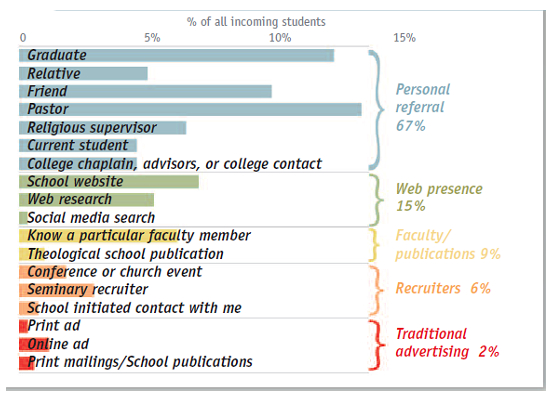Your institution has a plethora of data at its fingertips. Are you using that data to leaven your decision-making processes? Do the members of your board, administration, faculty, and staff know what information is available and how it applies to your specific context?
| The Question: What compelled you to find out more about this institution? |
 |
Interpreting the Entering Student Questionnaire
Each year, many students who are beginning their studies at institutions within the Association of Theological Schools (ATS) complete the Entering Student Questionnaire (ESQ). The ESQ includes 40 questions on topics that range from debt to marketing to faculty. The graph on this page is from the ESQ for 2014-2015, which has been completed by more than 5,600 students so far.
INSIGHTS
As I review this data, several things stand out:
-
Nearly 70 percent of incoming students learned about their school through a personal referral.
-
Only 2.5 percent of incoming students learned about their school through traditional advertising, which pales in comparison to the 15 percent who learned about it through the web.
-
Only 8.6 percent learned about their school because they knew a faculty member or read a theological publication from their school.
APPLICATION
Looking at this aggregate data may prompt you to review what is happening at your own institution. It may be that you have similar results — or perhaps you are the exception. You don’t know until you look at your own data! Then, consider how your marketing efforts align with results.
When it comes to generating prospective students, word-of-mouth marketing appears to be significantly more valuable than all other types of marketing. At the same time, it’s reasonable to conclude that a well-designed online presence can be a good support system to bolster recommendations by graduates, pastors, and others. Certainly all recruiting efforts should be coordinated so that whether potential students hear about you through a conference, a professor, or a website, they’re getting a similar message.
NEXT STEPS
If your institution participates in the ESQ, you can easily compare your school’s data to industry-wide data. Therefore, step 1 is to look at your data and share it with your faculty, staff, board, and administration.
Step 2 is to review, at a macro or institutional level, how your strategic planning and your recruiting initiatives align with reality. Are you allocating your staff and resources appropriately?
Finally, step 3, at a micro or day-to-day level, consider how you may need to adjust specific activities related to the data. After you have aligned staffing resources and institutional budgets, it may make sense to adjust specific activities to build on lessons from the data.
For example, you may decide to move money and people toward referral-based marketing, but if so, you may need to create a plan. Which referral-based activities will you pursue? Is your staff going to spend time with face-to-face visits, social media, or specific segments of the referral market?